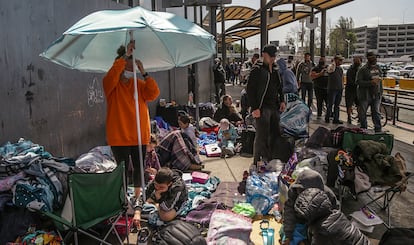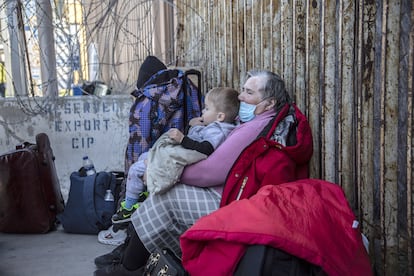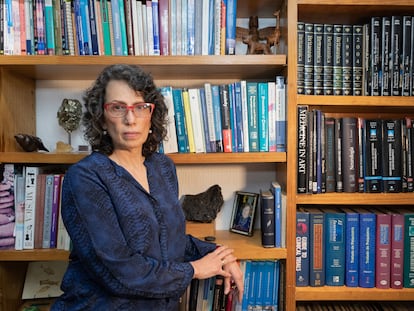The wall that separates Ukrainian and Russian refugees in America
The conflict in Europe is beginning to have an effect on the border between the United States and Mexico, which is one of the most intense migration points on the continent


Under a pedestrian bridge, a municipal police officer from Tijuana plays with his phone. From the inside of a car, he is watching a deserted, taped off square. El Chaparral, one of the pedestrian routes from Mexico to the United States, once held a camp of nearly 400 Central American migrants who wanted to enter California. They were cleared from the area on March 6. Now they are living in a number of shelters. The area is getting ready for the impeding crisis. On Wednesday, the officer pointed to the west, to San Ysidro, which is barely more than two kilometers away. “That’s where the Russians are arriving,” he says, keen to return to his cellphone. One of the borders with the most movement in America is awaiting the waves that the war in Europe have caused. The conflict on the other side of the world has, until now, seen three million Ukrainians flee their home country.
Ukrainians and Russians started to arrive on the border last week. They found the wall that the administration of US President Joe Biden has left intact, the one put in place by his predecessor Donald Trump. It’s a bureaucratic swamp that delays refugee and asylum requests, a mechanism that was damaged by the Republican politician and that the current government has promised to repair. But the resurgence of Vladimir Putin’s offensive in Ukraine has moved the gears in Washington. Anyone who shows their Ukrainian passport right now can enter the United States. On Sunday, 11 people passed. On Monday it was nine. A trickle of refugees has been arriving at a border point where, on average, 14,400 people a day cross. Citizens in the country under siege are, these days, the shooting stars on the border. Their passage cuts in two the mass ranks of people waiting to cross.
We know that the Ukrainians are the lucky ones right now,” explains Marc, 32, from Moscow, and who opts not to supply his surname. He’s one of the 30 or so Russians who have recently arrived in Tijuana. A delegate from the Baja California government has told news agency Reuters that more than 300 citizens with Russian nationality have arrived in the city in the last month.
A restaurant manager, Marc is opposed to the war and attended demonstrations against the conflict. He says that he had a good wage. He admits that he had some problems with the police, but won’t go into more detail because his parents and in-laws are still in his home country. “The war made clear to me that nothing will be the same in Russia,” he explains. “Things were going badly and now they can only go worse.”

He spent $2,000 on plane tickets for him and his wife Oxana, 29. They left for Turkey six days ago, and then to Germany, from where they flew to the tourist port of Cancun. Sat by the waves of the Caribbean, they wondered what to do with their lives. Four days later, there they were. They are sleeping on the asfalt, a few meters from the gate that they are hoping to cross with political asylum. “These are not vacations, we are fleeing,” he says. He’s blond, has his hair cut short and eyes that are a deep green color, and is wearing a Metallica t-shirt. He has no choice but to wait, even if it’s for a year. “There’s no going back to Russia for us,” he says.
The local authorities fear that this camp will get out of control in the coming weeks. The settlements, however, prompt optimism among many more. In less than a week, there were new arrivals fleeing the violence of war, a Colombian couple and even a Syrian, whose language of solidarity with the Russians was based in the exchange of cigarettes. Migrating is easier when it’s a collective dream.
In my opinion, there is a chance that Putin could launch a nuclear missile at EuropeYuri Savkin, 36
But on Wednesday, a council worker from Tijuana approached the group to hand over to them a letter that banned them from sleeping or living on the street. The text offered to take them to one of the shelters in the city. The document had taken some time to arrive, because they couldn’t find a translator who could write in Russian. The message left the new migrants greatly concerned.
Yuri Savkin, 36, traveled from Chernogolovka, 80 kilometers from Moscow, to Mexico City, where he landed on March 14. “In my opinion, there is a chance that Putin could launch a nuclear missile at Europe,” he says, with the help of Google Translate. With him are his wife Helen, 44, and Sonia, his nine-year-old daughter. “I decided to leave the country and not wait for the call from the Army, because I don’t want to fight against the civilian population nor obey criminal orders,” he says.
He’s wearing a smart Tommy Hilfiger jacket and there are traces of sunblock on his face. In his country, he was a businessman offering investment services. All of this has gone up in smoke with the sanctions that have been imposed by the West. He has $3,000 with him. He can’t touch the money he has in England – his cards have been blocked and his accounts frozen. Today his only privilege is to occupy the first spot next to the barbed wire fence at the border. He’s spent the last five days publishing his story on the social media accounts of US politicians. He has 180 days, the legal limit in Mexico, to get someone’s attention. “There’s no Plan B,” he warns.
Tu suscripción se está usando en otro dispositivo
¿Quieres añadir otro usuario a tu suscripción?
Si continúas leyendo en este dispositivo, no se podrá leer en el otro.
FlechaTu suscripción se está usando en otro dispositivo y solo puedes acceder a EL PAÍS desde un dispositivo a la vez.
Si quieres compartir tu cuenta, cambia tu suscripción a la modalidad Premium, así podrás añadir otro usuario. Cada uno accederá con su propia cuenta de email, lo que os permitirá personalizar vuestra experiencia en EL PAÍS.
¿Tienes una suscripción de empresa? Accede aquí para contratar más cuentas.
En el caso de no saber quién está usando tu cuenta, te recomendamos cambiar tu contraseña aquí.
Si decides continuar compartiendo tu cuenta, este mensaje se mostrará en tu dispositivo y en el de la otra persona que está usando tu cuenta de forma indefinida, afectando a tu experiencia de lectura. Puedes consultar aquí los términos y condiciones de la suscripción digital.
More information
Últimas noticias
Welcome to the post-religion era: The idea of Christianity as the absolute truth has become obsolete
‘I thought you would like it’: The risky sexual practice popularized by TV shows and TikTok
The digitalization of tourism: ‘They promise experiences and gave us the worst possible one’
Mexican peso defies uncertainty with forecasts of a new period of stability in 2026
Most viewed
- Sinaloa Cartel war is taking its toll on Los Chapitos
- Reinhard Genzel, Nobel laureate in physics: ‘One-minute videos will never give you the truth’
- Oona Chaplin: ‘I told James Cameron that I was living in a treehouse and starting a permaculture project with a friend’
- Why the price of coffee has skyrocketed: from Brazilian plantations to specialty coffee houses
- Silver prices are going crazy: This is what’s fueling the rally










































